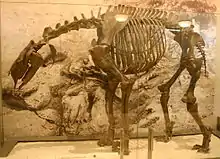Moropus
Moropus (meaning "slow foot") is an extinct genus of perissodactyl ("odd-toed" ungulate) mammal that belonged to the group called chalicotheres. They were endemic to North America during the Miocene from ~20.4—13.6 Mya, existing for approximately 6.8 million years .
| Moropus | |
|---|---|
 | |
| Moropus elatus skeleton at the National Museum of Natural History, Washington, DC | |
| Scientific classification | |
| Kingdom: | Animalia |
| Phylum: | Chordata |
| Class: | Mammalia |
| Order: | Perissodactyla |
| Family: | †Chalicotheriidae |
| Subfamily: | †Schizotheriinae |
| Genus: | †Moropus Marsh, 1877 |
| Species | |
The closest extant relatives of Moropus are other perissodactyls: horses, rhinos, and tapirs.[2]
Description
Like other chalicotheres, they differed from their modern relatives in having large claws, rather than hooves, on the front feet; these claws may have been used for defense or digging for food.[2] Moropus stood about 8 feet (2.4 m) tall at the shoulder. [3]The three highly compressed claw-like hooves on each foot were split down the middle. The name Moropus translates to "slow (or sloth) foot", implying it was a clumsy mover. However the articulation of the phalangeal (finger) bones, in addition to the likely presence of large foot and toe pads, shows that Moropus probably could raise the claws slightly to enable it to move about quite smoothly. The laterally compressed claws, less robust knuckles, and its large size suggest it didn't knuckle walk like other chalicotheres. Rather, they had a digitigrade stance and lifted their claws by hyperextension of the phalangeal hook.[4] As the hooves curved inward, it probably had a pigeon-toed gait. Another schizotheriine chalicothere, Ancylotherium, had a similar gait.

Fossil distribution

- Phillips Ranch, Kern County, California estimated age: ~18.7 Mya.
- Stewart Spring (UCMP 2027), Mineral County and Esmeralda County, Nevada estimated age: ~18.7 Mya.
- Stage Hill I, aka Millennium's End Quarry, Scotts Bluff County, Nebraska estimated age: ~21.6—21.5 Mya.
- Sucker Creek site, Sucker Creak Formation, Malheur County, Oregon ~16.4 Mya.
- Anderson Ranch Formation, Agate Fossil Beds National Monument, Nebraska estimated age ~ 21.3-19.2 Mya.
See also
References
- "Moropus in the Paleobiology Database". Fossilworks. Retrieved 2018-10-07.
- Palmer, D., ed. (1999). The Marshall Illustrated Encyclopedia of Dinosaurs and Prehistoric Animals. London: Marshall Editions. p. 261. ISBN 1-84028-152-9.
- Agate Fossils National Monument NPS Natural Resource Report NPS/NRPC/GRD/NRR-2009/080 (J. Graham, March 2009)
- Coombs, Margery Chalifoux (1983). "Large Mammalian Clawed Herbivores: A Comparative Study". Transactions of the American Philosophical Society. 73 (7): 1–96. doi:10.2307/3137420. ISSN 0065-9746. JSTOR 3137420.

